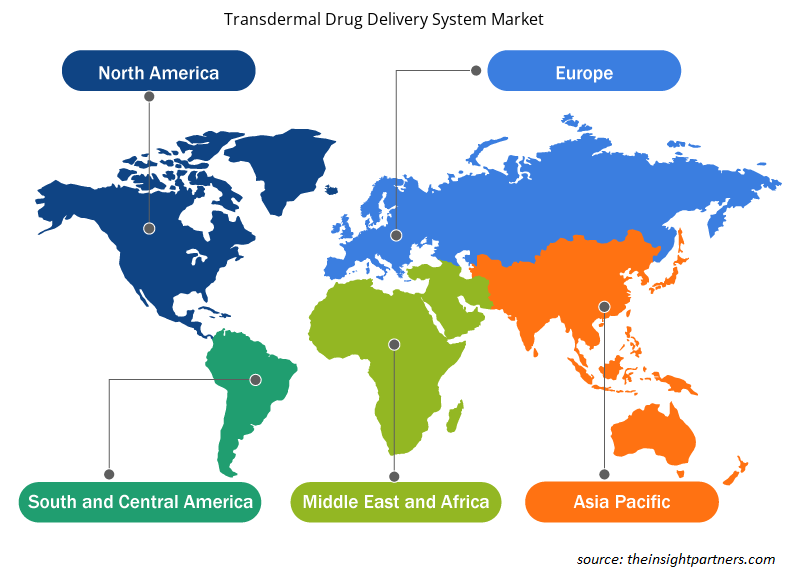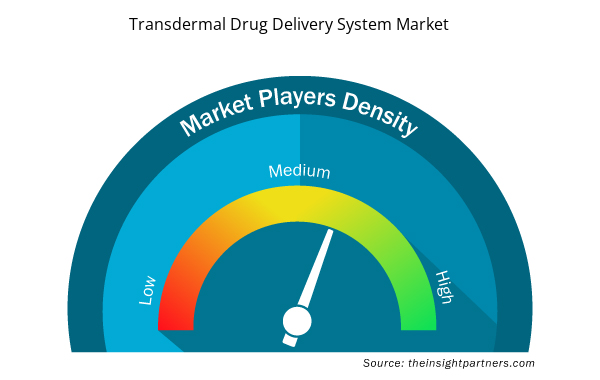The transdermal drug delivery system market is expected to grow from US$ 37,230.28 million in 2022 to US$ 51,949.74 million by 2030; it is anticipated to record a CAGR of 4.3% from 2022 to 2030. Strategic initiatives by manufacturers will likely remain a key trend in the market.
Transdermal Drug Delivery System Market Analysis
The increasing prevalence of chronic diseases, growing demand for noninvasive drug delivery devices, and high demand for self-administration of drugs are the key driving factors behind the market growth. Furthermore, adopting 3D printing technology and smart patches will likely offer opportunities to the transdermal drug delivery systems market in the coming years.
Transdermal Drug Delivery System Market Overview
Cardiovascular diseases (CVDs) such as angina, atherosclerosis, pectoris, and acute myocardial infarction are among the common causes of mortality in the world. According to the WHO, CVDs are the major cause of ~17.9 million deaths worldwide every year. Many medicines are commercially available for the treatment of CVDs, but conventional capsules and tablets are unable to control the ailment effectively. This underlines the need for novel drug delivery systems providing prolonged drug bioavailability and targeted drug delivery to the affected areas of the cardiovascular system. Transdermal drug delivery systems offer many advantages over regular orally administered drugs to treat cardiovascular diseases. Transdermal patches, encompassing drug particles, are applied on the skin surface. A cardiac patch provides an excellent platform for cell engraftment improvement. For example, a vascularized cardiac patch developed recently shows promising potential for treating ischemic heart injuries. Nitroglycerin transdermal patches are used to prevent angina (chest pain) episodes in people with coronary artery disease. They work by relaxing the blood vessels and reducing the heart's stress, lowering the need for oxygen. However, these patches cannot be used to treat angina attacks that have already begun.
Customize This Report To Suit Your Requirement
You will get customization on any report - free of charge - including parts of this report, or country-level analysis, Excel Data pack, as well as avail great offers and discounts for start-ups & universities
Transdermal Drug Delivery System Market: Strategic Insights

- Get Top Key Market Trends of this report.This FREE sample will include data analysis, ranging from market trends to estimates and forecasts.
Customize This Report To Suit Your Requirement
You will get customization on any report - free of charge - including parts of this report, or country-level analysis, Excel Data pack, as well as avail great offers and discounts for start-ups & universities
Transdermal Drug Delivery System Market: Strategic Insights

- Get Top Key Market Trends of this report.This FREE sample will include data analysis, ranging from market trends to estimates and forecasts.
Transdermal Drug Delivery System Market Drivers and Opportunities
Continuous Technological Advancement
Traditional drug delivery techniques such as intramuscular, intravenous, and rectal drug administration are not preferred by specific patient populations, mainly due to the pain and complexities associated with them. With the improvements in medical science and definite drug delivery technologies, noninvasive drug delivery systems are now set to compete with the traditional method of injectable drug administration. The noninvasive drug delivery systems include drug delivery via oral, topical, transdermal-active (device-aided enhanced penetration), and transdermal-passive; transocular membrane, transmucosal membrane, and alveolar membrane from inhaled medication. Transdermal drug delivery is advantageous in many ways over the oral route of administration. In particular, it evades the first-pass mechanism of the liver, which can otherwise impulsively metabolize drugs.
Advancements in Smart Patches and 3D-printed Patches
A transdermal drug administration route is novel and one of the reliable means of sustained drug delivery. With significant research being conducted in this field and the increasing interest of researchers in this form of drug delivery, many transdermal patches are likely to reach the marketplace in the future. Transdermal patches are used to deliver drugs such as nicotine, fentanyl, nitroglycerin, and clonidine to treat various medical conditions. Recently, these patches have been explored to deliver biologics in various applications. Smart patches are equipped with sensors and other technologies to monitor patient conditions and adjust drug delivery accordingly. In January 2023, a lead scientist at Swansea University developed a new smart patch to detect proinflammatory biomarkers of neurodegenerative diseases such as Parkinson's and Alzheimer's using the microneedle technology. These smart patches comprise numerous microneedles designed to penetrate the skin barrier in a minimally invasive manner, followed by monitoring the biomarkers of clinical significance. They can be self-administered for point-of-care diagnosis at general practices or home. This innovative research can potentially change the landscape of early neurodegenerative disease detection.
Transdermal Drug Delivery System Market Report Segmentation Analysis
Key segments that contributed to the derivation of the transdermal drug delivery system market analysis are product and end user.
- Based on type, the transdermal drug delivery system market is segmented into event transdermal patches, transdermal gel, transdermal sprays, and others. The transdermal patches segment held the largest market share in 2022.
- Based on application, the transdermal drug delivery system market is segmented by cardiovascular diseases, central nervous system disorders, pain management, hormonal applications, other applications. The pain management segment held a largest market share in 2022.
- Based on the distribution channel, the transdermal drug delivery system market is segmented by hospitals pharmacies, retail phamacies, online pharmacies, others. The hospitals pharmacies segment held a largest market share in 2022.
Transdermal Drug Delivery System Market Share Analysis by Geography
The geographic scope of the transdermal drug delivery system market report is mainly divided into five regions: North America, Asia Pacific, Europe, Middle East & Africa, and South & Central America.
The US is the largest market for transdermal drug delivery systems in North America. According to the American Heart Association (AHA), cardiovascular disease (CVD) remains the leading cause of death in the US. According to the CDC, in 2021, CVD accounted for ~695,000 deaths and ~1 in 5 deaths in the US. The rising prevalence of cardiovascular disease, diabetes, chronic pain conditions, and other chronic diseases drives the demand for effective and convenient treatment options. Medical patches offer a noninvasive and patient-friendly approach to deliver medication and manage symptoms associated with these chronic conditions. Ongoing advancements in TDDS, such as wearable sensors and flexible electronics, contribute to the growth of the transdermal drug delivery system market. These advancements allow for more accurate dosing, patient monitoring, and compliance. According to a report titled "Recent advances in transdermal drug delivery systems," published by Biomaterials Research in 2021, microneedles attract significant attention among TDDS modalities, which overcome the limitations of the existing simple application type and patch-type needles by combining the advantages of microneedles to obtain higher treatment efficiency and effects. Advances in these TDDS can provide the driving force for controlling the prevalence of cardiovascular and central nervous system diseases, diabetes, neuromuscular diseases, and infectious and localized infectious diseases..
Transdermal Drug Delivery System Market Regional Insights
The regional trends and factors influencing the Transdermal Drug Delivery System Market throughout the forecast period have been thoroughly explained by the analysts at Insight Partners. This section also discusses Transdermal Drug Delivery System Market segments and geography across North America, Europe, Asia Pacific, Middle East and Africa, and South and Central America.

- Get the Regional Specific Data for Transdermal Drug Delivery System Market
Transdermal Drug Delivery System Market Report Scope
| Report Attribute | Details |
|---|---|
| Market size in 2022 | US$ 37,230.28 Million |
| Market Size by 2030 | US$ 51,949.74 Million |
| Global CAGR (2022 - 2030) | 4.3% |
| Historical Data | 2020-2021 |
| Forecast period | 2022-2030 |
| Segments Covered |
By Type
|
| Regions and Countries Covered | North America
|
| Market leaders and key company profiles |
Transdermal Drug Delivery System Market Players Density: Understanding Its Impact on Business Dynamics
The Transdermal Drug Delivery System Market market is growing rapidly, driven by increasing end-user demand due to factors such as evolving consumer preferences, technological advancements, and greater awareness of the product's benefits. As demand rises, businesses are expanding their offerings, innovating to meet consumer needs, and capitalizing on emerging trends, which further fuels market growth.
Market players density refers to the distribution of firms or companies operating within a particular market or industry. It indicates how many competitors (market players) are present in a given market space relative to its size or total market value.
Major Companies operating in the Transdermal Drug Delivery System Market are:
- Novartis AG
- GSK Plc
- Viatris Inc
- Boehringer Ingelheim International GmbH
- Lavipharm SA
- Hisamitsu Pharmaceutical Co Inc
Disclaimer: The companies listed above are not ranked in any particular order.

- Get the Transdermal Drug Delivery System Market top key players overview
Transdermal Drug Delivery System Market News and Recent Developments
The Transdermal Drug Delivery System Market is evaluated by gathering qualitative and quantitative data post primary and secondary research, which includes important corporate publications, association data, and databases. A few of the developments in the transdermal drug delivery system market are listed below:
- Starton Therapeutics Inc. has filed provisional patent applications with the U.S. Patent and Trademark Office (USPTO) for unique and novel approaches to incorporate various active pharmaceutical ingredients (APIs) into transdermal drug delivery systems, where such APIs have typically been difficult to incorporate in a transdermal drug delivery system platform. (Source: Starton Therapeutics, Company Website, January 2024)
- Satio has received a $3.5 million Small Business Innovation Research (SBIR) contract from Advanced Research Projects Agency for Health (ARPA-H), National Institutes of Health, Department of Health and Human Services. This SatioRx device is designed to be compact and inexpensive, with disposable microneedle components that allow healthcare providers to remotely deliver a precise metered dose of any liquid drug approved for transdermal delivery by the FDA. Under this contract, Satio will leverage design features from its other patch-based devices and feasibility data from its manually operated transdermal delivery devices to develop the next-generation remotely controllable device. (Source: Satio, Company Website, September 2023)
Transdermal Drug Delivery System Market Report Coverage and Deliverables
The “Transdermal Drug Delivery System Market Size and Forecast (2020–2030)” report provides a detailed analysis of the market covering below areas:
- Transdermal drug delivery system market size and forecast at global, regional, and country levels for all the key market segments covered under the scope
- Transdermal drug delivery system market trends as well as market dynamics such as drivers, restraints, and key opportunities
- Detailed PEST/Porter’s Five Forces and SWOT analysis
- Transdermal drug delivery system market analysis covering key market trends, global and regional framework, major players, regulations, and recent market developments.
- Industry landscape and competition analysis covering market concentration, heat map analysis, prominent players, and recent developments for the transdermal drug delivery system market
- Detailed company profiles
- Historical Analysis (2 Years), Base Year, Forecast (7 Years) with CAGR
- PEST and SWOT Analysis
- Market Size Value / Volume - Global, Regional, Country
- Industry and Competitive Landscape
- Excel Dataset



Report Coverage
Revenue forecast, Company Analysis, Industry landscape, Growth factors, and Trends

Segment Covered
Type, Application, and Distribution Channel

Regional Scope
North America, Europe, Asia Pacific, Middle East & Africa, South & Central America

Country Scope
This text is related
to country scope.
Frequently Asked Questions
The market is expected to register a CAGR of 4.3% during 2023–2031.
Novartis AG, GSK Plc, Viatris Inc, Boehringer Ingelheim International GmbH, Lavipharm SA, Hisamitsu Pharmaceutical Co Inc, Johnson & Johnson, Luye Pharma Group Ltd, Purdue Pharma LP.
Strategic initiatives by manufacturers will likely remain a key trend in the market.
The increasing prevalence of chronic diseases, growing demand for noninvasive drug delivery devices, and high demand for self-administration of drugs are the key driving factors behind the market growth.
North America dominated the transdermal drug delivery system market in 2023

 Get Free Sample For
Get Free Sample For